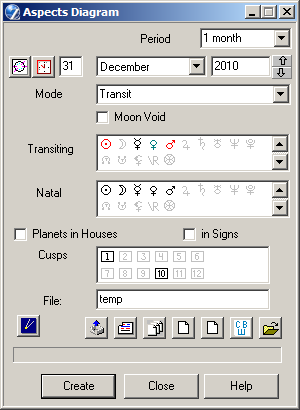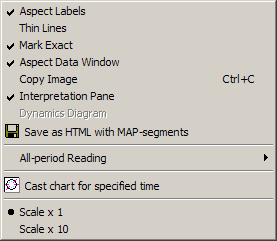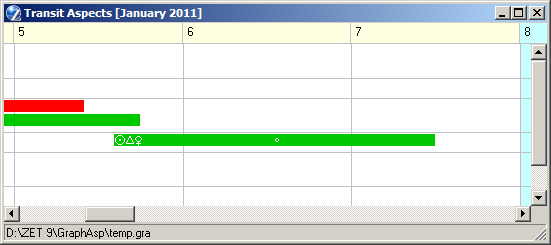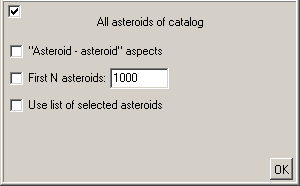Aspects Diagram
This function is not available in the Lite version of ZET.
The Aspects Diagram is a graphical listing of aspects taking place concurrently over a selected period of time. You can see their durations and instants of exactness, and obtain interpretations of individual aspects and of the whole period.
Suppose you want to view the prognostic for some natal chart as transit in January 2011, i.e. to find out what aspects existed (natal-transit aspects) during that month. Follow these steps:
- Open the Movement of Planets dialog by
clicking the
 "Tools" Toolbar button
or selecting "Tools" from the main menu, then
selecting the
"Tools" Toolbar button
or selecting "Tools" from the main menu, then
selecting the  "Aspects Diagram..."
menu option.
"Aspects Diagram..."
menu option.
Set the dialog as shown:
The example shows the Transiting box with the 4 innermost planets selected. (It includes glyphs for several other unselected bodies - do not be concerned if these are not in your box, as the contents depend on whatever asteroids, virtual planets and object, etc you have selected for use in charts). The name of the file for saving the result to has been input as 'temp', but you can use any name of your choice.
- Click Create and wait while the blue progress-bar indicates
on-going calculation.
You can cancel the calculation at any time by clicking the button with the red diagonal cross, if, for example, you have selected too many planets, or fast-moving planets and a large time period.
- When the calculation has completed, the Aspects Diagram window will be displayed:

The Aspects Diagram collates aspects by planet. For each planet, a colored horizontal line shows the duration of an aspect while in orb with another body. Colors correspond with the aspect colors used in the Chart tableau (they can be set in the orb tables). Exactness of aspect is indicated by little circles. The length of lines depends on the selected orb table (Chart Settings - Aspects tab). For this screenshot 1-degree orbs were used.
Pausing the mouse pointer on an aspect line displays the following information:
- Window title bar - names of the planets and the aspect,
- Status line - start date and time, date(s) and time(s) of exactness, and end date and time.
This information can be displayed in a separate Aspect Data window, if it is more convenient:

The first line in this window displays the time when the aspect starts. The next line shows indented the time of aspect exactness; there may be several such lines, if the planet makes loops. The last line shows the aspect's end time.
Left-clicking and dragging the mouse in the diagram displays a vertical blue cursor line which reads out dates and times - displayed in the window title bar.
Left clicking on colored strip of any aspect invokes the interpretation of this aspect of with an indication of the validity period of time and the exact of aspect. Desired font size of the text interpretation can be set as follows:
- on a chart's wheel invoke a popup menu of any planet (by right-click),
- choose "Interpretation",
- invoke a popup menu of window which appears,
- choose "Font...",
- choose appropriate font size in a window which appears.
The settings for creating Aspects Diagrams are similar to those for creating a Graphic Ephemeris. The following are specific to Aspects Diagrams:
Planets in House - when checked, the Diagram shows the sojourn of the selected planets in houses of the natal chart, from ingress to egress. This option is available only when the Mode implies different radix and event data, i.e. Transit, Progression, or one of the Directions.
Cusps checkboxes - allows the selection of individual cusps as targets of aspects from planets. As with Planets in Houses, it requires that the selected period refer to a radix of a different date from the date of interest.
Aspects Diagrams are created using the current orb table - you should check that these orbs are as you require them.
Right-click in the window to invoke a popup menu:

The menu functions are as follows:
- Aspect Labels - switches the display of legends identifying the aspects,
- Thin Lines - switches the format of aspects between bars (the default) and thin lines,
- Mark Exact - displays index markers on the aspect bars indicating when the aspects are exact,
- Aspect Data Window - see above,
- Copy Image - to the Windows Clipboard,
- Interpretation Pane - displays an interpretation pane in the lower part of the window. The size of the pane is adjustable. When displayed, clicking an aspect displays its interpretation in the pane (subject to the availability of appropriate texts). The Operational Bookshelf is used (see Horoscope Readings),
- Dynamics Diagram - see Aspect Dynamics.
- Save as HTML with MAP-segments - displays a File Save dialog to create an HTML Web-format file with a mouse-sensitive copy of the diagram,
- All-period reading - compiles and displays a comprehensive interpretation of all the aspects in the period,
- Cast chart for specified time - casts a chart on the date and time specified by position of the mouse cursor when calling this menu.
- Scale x 1 - selects the default initial size of diagram,
- Scale x 10 - magnifies the diagram 10 times for detailed viewing. For example (with the "Aspect Labels" menu option checkedmarked):

To reopen an previously created diagram, click the  "File..."
button, select a diagram file in the Open dialog, and click the
"File..."
button, select a diagram file in the Open dialog, and click the
 "View Diagram" button.
"View Diagram" button.
To filter (reduce) the diagram data, set appropriate parameters in the Movement of Planets window. For example, deselect the glyphs of Pholus and Lennon to cut these asteroids from the diagram; or set the period to "1 month" and specify one month's display in the diagram.
To set the parameters of the dialog from a previously created diagram,
click the  "Take parameters of Diagram"
button.
"Take parameters of Diagram"
button.
To get a full list of aspects in the diagram, click the
 "Full list of aspects" button. A
fragment of such a list might include:
"Full list of aspects" button. A
fragment of such a list might include:
Mundane aspects
Begin: 1.01.2003 Period: 1 year Time: GMT+1
Orb Begin of Aspect End of Aspect Exact Aspect
Neptune 0 Lennon 1.0 11.01.2003 1:00 15.01.2003 1:00 13.01.2003 0:51
Jupiter 180 Neptune 1.0 10.02.2003 13:00 22.02.2003 13:00 16.02.2003 10:13
Jupiter 180 Neptune 1.0 28.05.2003 1:00 9.06.2003 1:00 3.06.2003 3:54
Saturn 120 Uranus 1.0 18.06.2003 1:00 1.07.2003 13:00 25.06.2003 0:35
Jupiter 120 Pluto 1.0 27.06.2003 1:00 6.07.2003 1:00 1.07.2003 13:46
Jupiter 90 Pholus 1.0 27.06.2003 13:00 6.07.2003 1:00 1.07.2003 16:28
Jupiter 180 Uranus 1.0 26.08.2003 13:00 3.09.2003 1:00 30.08.2003 5:37
Jupiter 120 Lennon 1.0 19.09.2003 13:00 25.09.2003 1:00 22.09.2003 8:10
Uranus 60 Lennon 1.0 19.10.2003 1:00 26.10.2003 13:00 22.10.2003 16:21
Jupiter 60 Saturn 1.0 27.10.2003 1:00 7.11.2003 1:00 1.11.2003 18:12
To get an abbreviated list of the diagram's aspects, click the
 "Abbreviated list of aspects" button.
A fragment of such a list might include:
"Abbreviated list of aspects" button.
A fragment of such a list might include:
Mundane aspects
Begin: 1.01.2003 Period: 1 year Time: GMT+1
Aspect Exact
Neptune 0 Lennon 13.01.2003 0:51
Jupiter 180 Neptune 16.02.2003 10:13
Jupiter 180 Neptune 3.06.2003 3:54
Saturn 120 Uranus 25.06.2003 0:35
Jupiter 120 Pluto 1.07.2003 13:46
Jupiter 90 Pholus 1.07.2003 16:28
Jupiter 180 Uranus 30.08.2003 5:37
Jupiter 120 Lennon 22.09.2003 8:10
Uranus 60 Lennon 22.10.2003 16:21
Jupiter 60 Saturn 1.11.2003 18:12
All asteroids
There is "All asteroids of catalog" option, allows for transits and actual aspects to consider all asteroids, contains in catalog of asteroids, or specified number of first asteroids of catalog, or any set of asteroids, listed in "aselected.txt" file.
If press  "All asteroids of catalog" button,
then following panel opens:
"All asteroids of catalog" button,
then following panel opens:

Along with main "All asteroids of catalog" option there are:
- "Asteroid-asteroid aspects" option, if checked, then in the "actual aspects" mode considered all mutual of all asteroids of catalog,
- "First N asteroids" option, if checked, then considered a number of first asteroids of catalog, specified in a rightmost field,
- "Use list of selected asteroids" option, if checked, then considered only asteroids, listed in "aselected.txt" file, this file contanes the asteroids names, one name by string,
- "OK" button used to close this panel.
The  button at the sane time is the indicator
of "All asteroids of catalog" option: if pressed (down), then the option is on,
if unpressed (up), then off. You may open the "All asteroids of catalog" panel
without pressing this button, but just click it by right mouse button.
button at the sane time is the indicator
of "All asteroids of catalog" option: if pressed (down), then the option is on,
if unpressed (up), then off. You may open the "All asteroids of catalog" panel
without pressing this button, but just click it by right mouse button.
Note: the result displyed at tabulated (not graphical) formats only.
